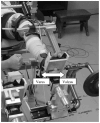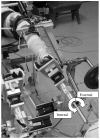Varus/valgus and internal/external torsional knee joint stiffness differs between sexes
- PMID: 18535251
- PMCID: PMC2562882
- DOI: 10.1177/0363546508317411
Varus/valgus and internal/external torsional knee joint stiffness differs between sexes
Abstract
Background: Torsional joint stiffness is thought to play a role in the observed sex bias in noncontact anterior cruciate ligament injury rates.
Hypothesis: Women will exhibit lower torsional stiffness values of the knee in response to varus/valgus and internal/external rotations than will men.
Study design: Controlled laboratory study.
Methods: Knee kinematics of 20 university students (10 men, 27.3 +/- 3.4 years, 177.3 +/- 6.8 cm, 81.1 +/- 7.0 kg; 10 women, 22.9 +/- 1.5 years, 169.0 +/- 7.1 cm, 66.1 +/- 11.4 kg) were measured while 0 to 10 N . m of varus and valgus torques were applied with the subject nonweightbearing and while 0 to 5 N . m of internal and external torques were applied with the subject nonweightbearing and weightbearing with the use of a custom joint testing device. Joint stiffness values were calculated at 1-N . m increments.
Results: When low magnitudes of torque were applied to the knee, women had significantly lower stiffness values than did men. With the exception of applied external torque with the joint weightbearing and varus torque with the joint nonweightbearing, women demonstrated an increase in joint stiffness as the magnitude of torque increased from lower to higher magnitudes. In contrast, for the men, joint stiffness values remained unchanged as the magnitude of applied torque increased.
Conclusion: Women exhibited lower knee stiffness in response to low magnitudes of applied torque compared to men and demonstrated an increase of joint stiffness as the magnitude of applied torque increased.
Clinical relevance: The decreased stiffness behavior of the knee in response to low torques that was observed for women may have a role in detrimentally affecting knee biomechanics and resulting neuromuscular function, particularly when an individual transitions from nonweightbearing to weightbearing.
Figures









References
-
- Arampatzis A, Bruggemann GP, Metzler V. The effect of speed on leg stiffness and joint kinetics in human running. J Biomech. 1999;32:1349–1353. - PubMed
-
- Boden BP, Dean GS, Feagin JA, Garrett WE. Mechanisms of anterior cruciate ligament injury. Orthopedics. 2000;23:573–578. - PubMed
-
- Bryant JT, Cooke TD. Standardized biomechanical measurement for varus-valgus stiffness and rotation in normal knees. J Orthop Res. 1988;6:863–870. - PubMed
-
- Butler RJ, Crowell HP, 3, Davis IM. Lower extremity stiffness: implications for performance and injury. Clin Biomech (Bristol, Avon) 2003;18:511–517. - PubMed
-
- Carcia CR, Shultz SJ, Granata KP, Gansneder BM, Perrin DH. Knee ligament behavior following a controlled loading protocol does not differ by menstrual cycle day. Clin Biomech (Bristol, Avon) 2004;19:1048–1054. - PubMed
Publication types
MeSH terms
Grants and funding
LinkOut - more resources
Full Text Sources

